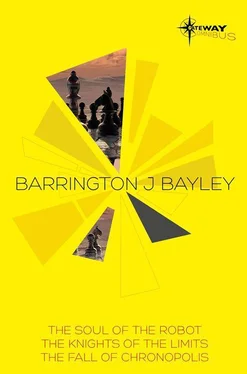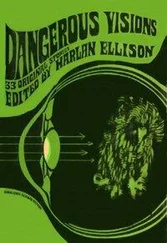Following this, the Knight expressed his gratitude and announced his intention to leave. I begged him to stay a while; but he replied that to continue meshing the spatial laws of the ship (i.e: locational-transitional laws) with the pieces on the chessboard was proving to be a drain on the power unit. Guiltily, I confess that I allowed selfishness to come to the fore here. Did he not owe me something for the help I had given him, I argued? Could he and his crew not spend a little more energy, and would it truly endanger their lives? My unethical blackmail was prompted solely by my burning desire to learn as much as I could while the opportunity remained. I think he understood my feelings for, after a brief hesitation, he agreed to remain and discourse with me for a short time, or at least until the power drain approached a critical level.
Eagerly I besought him to tell me as much as he could of this vast universe of divers space-times to which he had access but I had not. To begin with, where did the Knight’s own spatial realm lie? Was it beyond the boundaries of our own space (beyond infinity!) or was it at right angles to it in another dimension? (I babbled carelessly, forgetting his former objection to the term.) Or was it, perhaps, co-extensive with our continuum, passing unnoticed because its own mode of existence is so unutterably different from it? To all these hasty suggestions the Knight replied by chiding me gently for my naivety. I would never know the answer while I persisted in thinking in a such a way, he said, for the simple reason that there was no answer and no question . While I was still capable of asking this non-existent question the non-answer would never be apparent to me.
Somewhat abashed, I asked a more pertinent question: was each space-time unique, or was each type duplicated over and over? As far as was known, the Knight said, each was unique, but they were classified by similarities and some differed only in details or in the quantitative value of some physical constant. It was to be expected, for instance, that there would be a range of stereo space-times resembling our own but with different values on the velocity of light. To my next request, that he describe some alien space-times to me, he explained that many would be totally inconceivable to me and that there was no way to express them in my language, mathematical or spoken. The majority of the spaces that were known to the chess-people were variations on the locational-transitional theme. There was a theory in his home world that locational-transitional (or chessboard) space was the basic kind of space in the universe and that all others were permutations and variants of it; but he agreed with me that this theory could be suspected of special pleading and that deeper penetration into the universe by the chess-people’s spaceships might well bring home a different story. He would not bore me, he added, by describing meaningless variations on locational-transitional space, but felt that I would be more entertained by those spaces whose qualities made striking comparisons with the qualities of my own realm.
There was, for instance, a space that, though continuous, was not symmetrical in all directions but was hung between two great poles like a magnetic field. Motion along the direction of the axis between the poles was as easy as it is for us, but transverse movement was an altogether different phenomenon that required a different type of energy and a different name. This polarisation continued down into every event and structure, which was invariably positioned between two opposing poles of one kind or another. There was stereo space with great cracks of nullity running all through it, chasms of zero-existence which were impossible to cross and had to be gone round. There was space where an entity could travel in a straight line without incident, but where on changing direction he shed similar, though not identical, duplicates of himself which continued to accompany him thereafter. Prior to their rescue by me the Knight and his crew had believed themselves to be in such a space, for they had chanced to catch a glimpse of a woman accompanied by several daughters of various ages who closely resembled her. Also along these lines, there was a space where the image of an object or entity had the same powers and qualities as the original. This space abounded in mirrors and reflecting surfaces, and an entity was liable to project himself in all directions like a volley of arrows.
When you think about it, the necessity to be in only one place at a time is a pretty severe restriction. Many are the spaces where this law has never been heard of, and where an entity may multiply himself simultaneously into disparate situations without prejudice to his psychic integrity, roaming over the world in a number of bodies yet remaining a single individual. Chameleons have caused some puzzlement among biologists because their eyes operate independently of one another; the right eye knoweth not what the left eye is doing but each scans separately for prey or enemies. Does the consciousness of the chameleon give its full attention to both eyes simultaneously? If so, the chameleon is a mental giant which no human being can equal. This feat is a natural function, however, in the space of ‘multiple individuality’ I have described.
The Knight warned me against a restrictive concept of motion. It was not, he said, an idea of universal validity, but what we understood by motion could be subsumed under a more generalised concept he called ‘transformation’, a much larger class of phenomena. Thus there were spaces where to go was to come, where to approach was to recede, where to say goodbye was to say hello. In short, my maxim which says that to approach one point is to recede from another is not a universal law but a local case. Inversely, there were types of transformation that no mangling of the English language could succeed in hinting at. Once again the Knight suggested that I waste none of our precious time in trying to understand these inconceivable variations.
He spent some words in describing spaces that were not totally homogeneous. The space with cracks was one of these; another was ‘sheaving space’ with a quite odd quirk: the space split itself up into branches not all of which had any possible communication or influence with one another, even though they might all communicate with some common branch. Thus both A and B might communicate with C, but it would still be impossible for any message or particle to pass from A to B even via C. The separate branches usually contained innumerable worlds, with bizarre results.
Space can also vary in the quality of time it contains. (The Knight was quite firm in asserting that time is a subsidiary feature of space.) Time is not always irreversible, but in some spaces can be revisited by retracing one’s steps. The Knight fascinated me by telling of one space which he called ‘a space of forking time’ where every incident had not one but several possible outcomes, all equally real. Thus space branches continually in this continuum to develop alternate histories; where this space differs from the stock science-fiction notion, however, is that every past event is recoverable , and hence all possible histories communicate . By retracing his steps in a certain manner a man (or entity) can go back to the crucial moment that determined the shape of events and take a different path. When I reflected on how the fate and happiness of men is tyrannised over in our space by the singleness of time and the cruel dice-throwing of fleeting happenstance, this realm appeared to me to be a perfect abode of happiness.
It will be obvious that causality is governed by the type of space in which it takes place. The Knight mentioned that our space contains the principle of ‘single-instance causality’, which is also the principle obtaining in most space-times, and means that prolonged and complex processes can come to completion only with difficulty. The reason is thus: if A causes B, and B causes C, it still does not follow that A will lead to C because in the interim B might be modified by interceding influences and fail to cause C. There are, claimed the Knight, space-times of extended causality where every process or project reaches completion and no tendency is ever interrupted. As the realising of ambitions is automatic any ‘effort to succeed’ is quite redundant in this space-time. The struggle and drama of life consists not of trying to actualise intentions but of the struggle to form intentions in the first place.
Читать дальше












